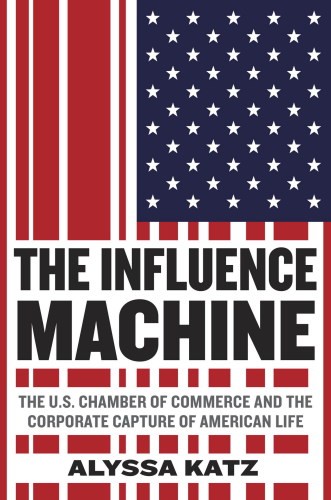
The Influence Machine
The U.S. Chamber of Commerce and the Corporate Capture of American Life
کتاب های مرتبط
- اطلاعات
- نقد و بررسی
- دیدگاه کاربران
نقد و بررسی

May 18, 2015
With clarity and verve, but without polemic, investigative journalist Katz (Our Lot) describes the U.S. Chamber of Commerce’s evolution into a many-armed behemoth. Katz credits the group’s impressive and increasing influence over national politics to its ambitious CEO, Tom Donohue, who has turned the tax-exempt entity into “Washington’s most powerful lobbying machine.” Some readers will feel disheartened, others awed, by Katz’s account of how, acting on its pledge to curb government growth, the Chamber of Commerce has tirelessly obstructed consumer protections, environmental regulation, financial reform, and health care legislation. Strong on journalism if lighter on analysis, Katz illustrates with several examples of how the organization has managed to influence courts, strong-arm Congress, cripple federal agencies, and sway the public with “voter education” ads—and, more recently, it has exported cutthroat American business practices abroad. Katz suggests that the Chamber of Commerce’s true commitment, despite its public-spirited rhetoric, is to deep-pocketed and anonymous legacy polluters, like the coal, tobacco, and chemical industries. While the book ends on an optimistic note, encouraging other, more public-spirited organizations to learn from the Chamber of Commerce’s path to power, readers might wonder if the Goliath described by Katz is simply too big to fail. Agent: Larry Weissman, Larry Weissman.

May 15, 2015
Of graft, fictional math, and the American way: an urgent look at the "political assault weapon" that is transforming the country-for the better if you're rich, for the worse if you're not. That the 1 percent is now wholly in charge and the United States has become the world's largest plutocracy are facts that would seem indisputable, much like climate change-which isn't to say that they won't be disputed. How we got there is another matter. Katz (Our Lot: How Real Estate Came to Own Us, 2009), an investigative journalist and member of the editorial board of the New York Daily News, does invaluable work in tracing how the U.S. Chamber of Commerce has been a relentless engine for pressing a "business of enterprise unfettered by government." It accomplishes its ends by taking the millions of dollars channeled into the chamber by its member organizations and pouring them into the coffers of powerful lobbyists to battle such nefarious things as the requirement that long-haul truckers take a certain number of hours off for every number of hours that they drive. As Katz argues, the amount of money that this enforced break costs industry is negligible compared to the additional safety achieved, but that's not the point. The chamber, it seems, wants no rules, and certainly no taxes, and it's prepared to go to battle any time to achieve that end-even against supposed allies such as the Bush administration, one of whose Cabinet members dared suggest that these rules have a socially beneficial purpose. It was not always that way, however. As Katz writes, documenting her every assertion, the chamber began as a "careful and not especially vocal presence in Washington" that was transformed by hard rightists into an organization whose purpose is to change the argument from "how much more to tax, spend, and regulate" to "how much less to tax, spend, and regulate." An eye-opening, maddening read that is not likely to make the Heritage Foundation's best-books list.
COPYRIGHT(2015) Kirkus Reviews, ALL RIGHTS RESERVED.

June 1, 2015
While the image of the chamber of commerce might evoke local businesspeople looking out for small-business interests, the U.S. Chamber of Commerce, Katz asserts, has developed powerful influence in Washington to protect the interests of the biggest of big businesses in America. Its influence is so enormouselecting supporters, punishing opponents, helping to write legislation and regulationsthat it has made government a tool of big business. Katz cites several examples, including the Affordable Care Act watered down to suit the interests of the insurance industry, preventing highway safety laws that would have shortened the hours that truck drivers could be behind the wheel, and reduction of class action suits against manufacturers. Katz details myriad laws and regulations in the environmental, health care, and other arenas where the chamber has exerted its influence. She details the history of the chamber and the polarized political climate that has energized it. There is rising discontent, however, among local chambers about the tactics and ideology of the chamber that, despite its mantra of free enterprise, protects the interest of its members from competition as well as from government regulation.(Reprinted with permission of Booklist, copyright 2015, American Library Association.)

























دیدگاه کاربران